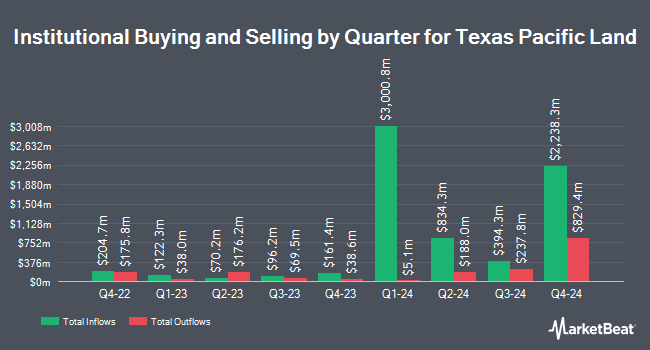Bank of New York Mellon Corp lessened its stake in Texas Pacific Land Corporation (NYSE:TPL - Free Report) by 0.5% during the first quarter, according to its most recent filing with the Securities and Exchange Commission. The fund owned 148,216 shares of the financial services provider's stock after selling 673 shares during the period. Bank of New York Mellon Corp owned about 0.64% of Texas Pacific Land worth $196,385,000 as of its most recent SEC filing.
A number of other institutional investors have also recently made changes to their positions in TPL. Bessemer Group Inc. grew its position in shares of Texas Pacific Land by 108.3% in the 4th quarter. Bessemer Group Inc. now owns 25 shares of the financial services provider's stock valued at $28,000 after buying an additional 13 shares during the last quarter. Golden State Wealth Management LLC grew its position in shares of Texas Pacific Land by 110.0% in the 1st quarter. Golden State Wealth Management LLC now owns 21 shares of the financial services provider's stock valued at $28,000 after buying an additional 11 shares during the last quarter. Assetmark Inc. bought a new stake in shares of Texas Pacific Land in the 4th quarter valued at about $29,000. Atala Financial Inc bought a new stake in shares of Texas Pacific Land in the 4th quarter valued at about $31,000. Finally, MassMutual Private Wealth & Trust FSB boosted its position in shares of Texas Pacific Land by 175.0% during the 1st quarter. MassMutual Private Wealth & Trust FSB now owns 33 shares of the financial services provider's stock valued at $44,000 after purchasing an additional 21 shares in the last quarter. Institutional investors own 59.94% of the company's stock.
Texas Pacific Land Price Performance
Shares of Texas Pacific Land stock traded down $5.96 on Friday, hitting $1,045.07. 109,702 shares of the company's stock traded hands, compared to its average volume of 147,313. Texas Pacific Land Corporation has a one year low of $736.75 and a one year high of $1,769.14. The company has a fifty day moving average of $1,173.20 and a two-hundred day moving average of $1,260.19. The company has a market capitalization of $24.03 billion, a price-to-earnings ratio of 52.28 and a beta of 1.08.
Texas Pacific Land (NYSE:TPL - Get Free Report) last announced its earnings results on Wednesday, May 7th. The financial services provider reported $5.24 EPS for the quarter, missing the consensus estimate of $5.27 by ($0.03). Texas Pacific Land had a net margin of 63.24% and a return on equity of 40.04%. The business had revenue of $195.98 million for the quarter, compared to the consensus estimate of $211.00 million.
Texas Pacific Land Announces Dividend
The firm also recently announced a quarterly dividend, which was paid on Monday, June 16th. Investors of record on Monday, June 2nd were given a dividend of $1.60 per share. The ex-dividend date of this dividend was Monday, June 2nd. This represents a $6.40 annualized dividend and a dividend yield of 0.61%. Texas Pacific Land's payout ratio is 32.02%.
Texas Pacific Land Profile
(
Free Report)
Texas Pacific Land Corporation engages in the land and resource management, and water services and operations businesses. The company owns a 1/128th nonparticipating perpetual oil and gas royalty interest (NPRI) under approximately 85,000 acres of land; a 1/16th NPRI under approximately 371,000 acres of land; and approximately 4,000 additional net royalty acres, total of approximately 195,000 NRA located in the western part of Texas.
See Also

Before you consider Texas Pacific Land, you'll want to hear this.
MarketBeat keeps track of Wall Street's top-rated and best performing research analysts and the stocks they recommend to their clients on a daily basis. MarketBeat has identified the five stocks that top analysts are quietly whispering to their clients to buy now before the broader market catches on... and Texas Pacific Land wasn't on the list.
While Texas Pacific Land currently has a Buy rating among analysts, top-rated analysts believe these five stocks are better buys.
View The Five Stocks Here
MarketBeat's analysts have just released their top five short plays for August 2025. Learn which stocks have the most short interest and how to trade them. Enter your email address to see which companies made the list.
Get This Free Report
Like this article? Share it with a colleague.
Link copied to clipboard.